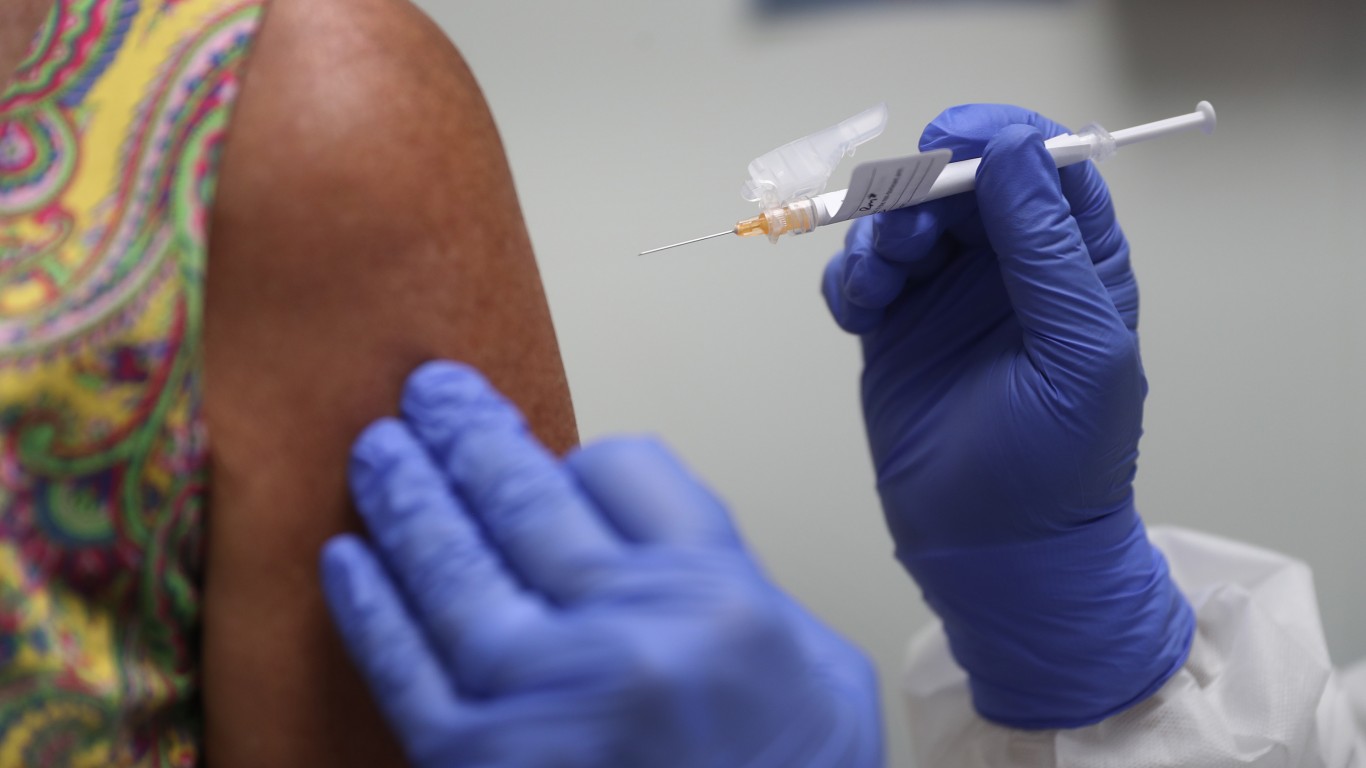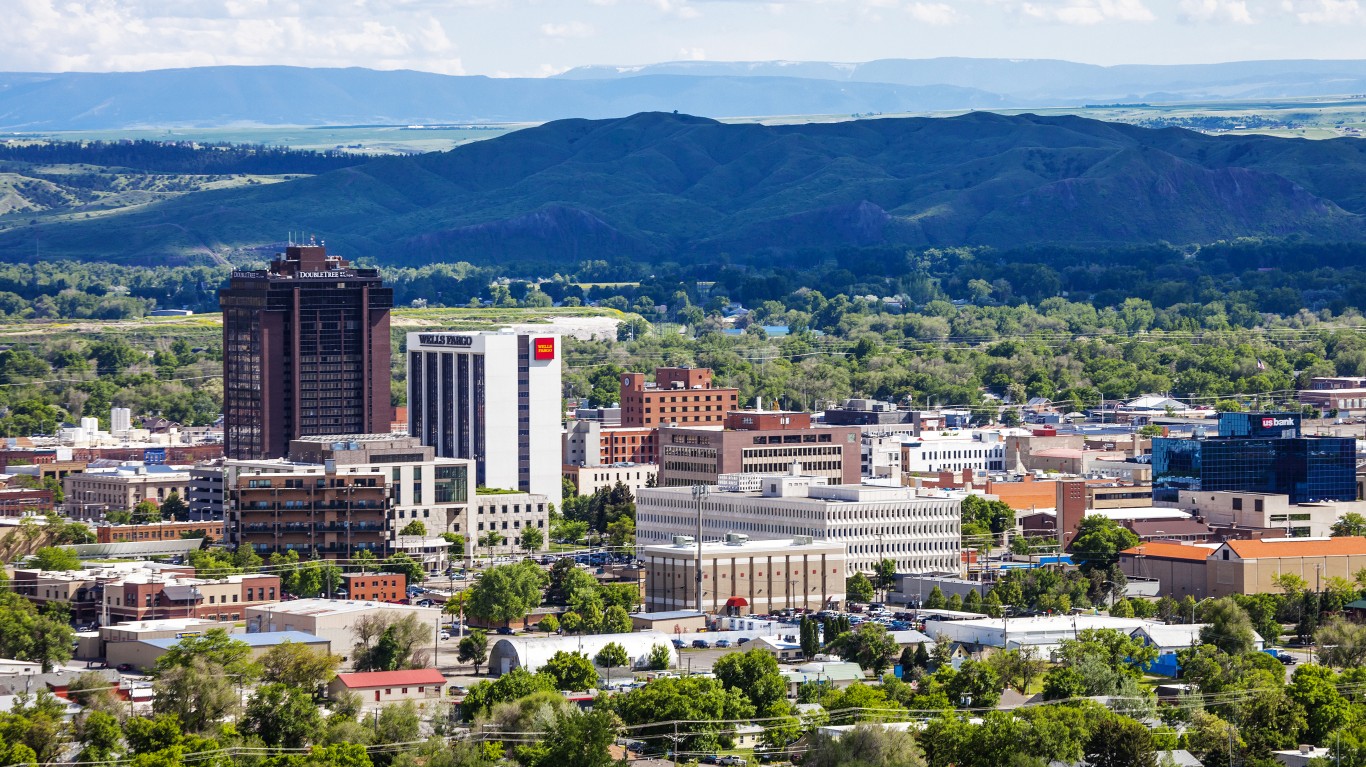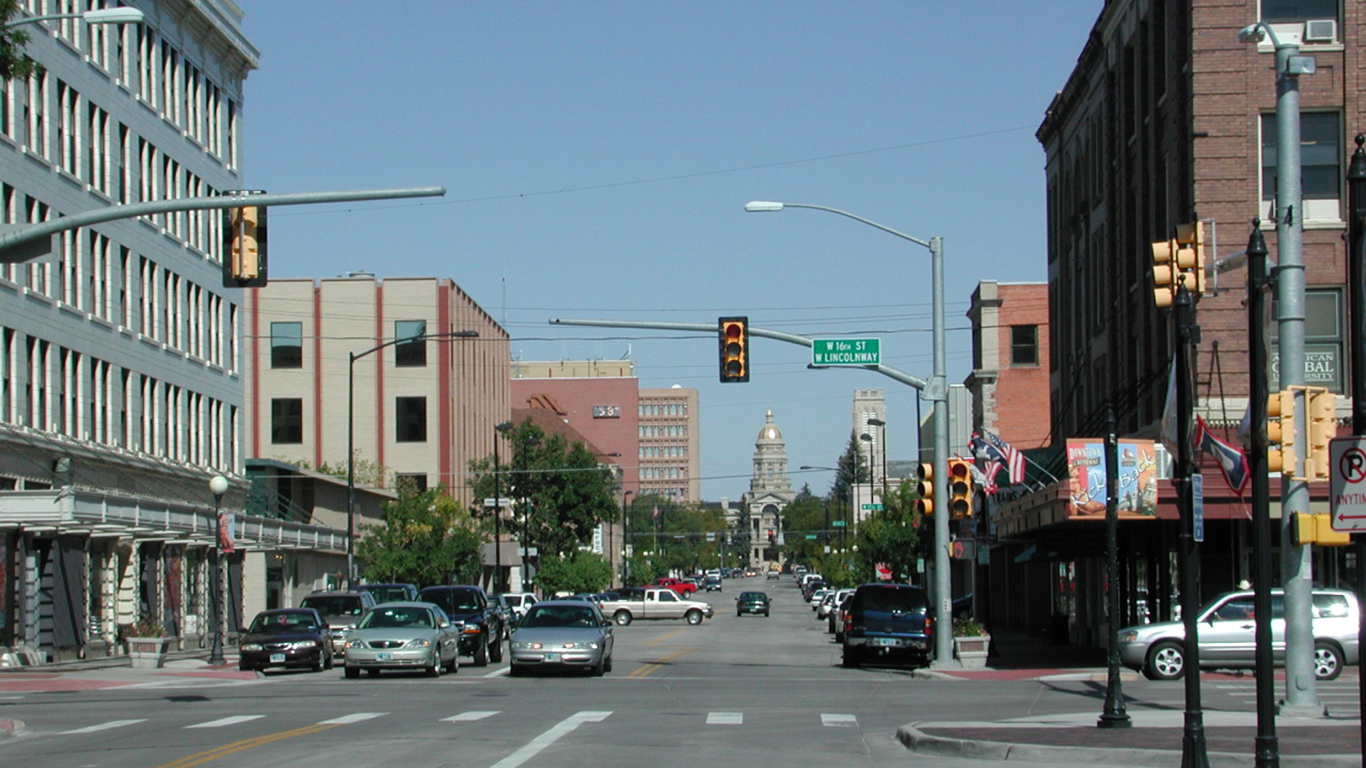Special Report
States Getting the Most COVID-19 Vaccines From the Federal Government

Published:

It has now been 16 weeks since the first shipments of the COVID-19 vaccine were sent out to states, kicking off the largest vaccination campaign in human history. As of Apr. 4, 207,891,295 doses of the vaccine have been sent out across the country — equivalent to 63.3% of the U.S. population.
While the distribution of the vaccine is taking longer than initial federal projections had indicated, some states are faring far better than others. Under the current system, named Operation Warp Speed, the Centers for Disease Control and Prevention sends states limited shipments of the vaccine as well as funding and tasks them with distributing the vaccine in accordance with relatively loose federal guidelines. The initial distribution of the vaccine is based on the size of the adult population in every state, which — according to some experts — can create inequities in states where a larger share of the population is at risk.
At this stage of the vaccine rollout, distribution of the vaccine varies widely from state to state. While the CDC has so far sent out an average of 63,335.2 vaccine doses per 100,000 Americans, Alaska has received 87,030 doses per 100,000 residents — the most of any state. Meanwhile, Utah has received 54,068 doses per 100,000, the fewest of any state.
While the distribution of the vaccine is determined by a formula based on the size of the adult population in each state, smaller states have so far received an outsized allotment of doses. As of Apr. 4, the 10 smallest states have received an average of 69,782 doses of the vaccine per 100,000 residents. In comparison, the 10 largest states have received an average of 62,521 doses per 100,000 residents.
While the federal government distributes vaccines to states, it is up to state governments to administer the vaccine — creating variations in both the percentage of vaccines that have been administered and the percentage of the population that has been vaccinated. In Wisconsin, 92.4% of vaccine doses have been administered, the most of any state and far greater than the 79.4% national average. In Alabama, 64.3% of vaccine doses have been administered, the least of any state.
At this stage of the rollout, the number of doses administered in New Mexico is equivalent to 65.1% of the state population — the largest share of any state. The lowest vaccination rate is in Alabama, where 37.9% of residents have received a dose of the vaccine. Nationwide, the number of doses administered is equivalent to 50.3% of the U.S. population.
While a majority of Americans remain unvaccinated due to a lack of supply, there are some who have no plans to receive a vaccine at all. According to a survey from the U.S. Census Bureau, 26.3% of U.S. adults 18 and over who have not yet received the vaccine will either probably not or definitely not get a COVID-19 vaccine in the future. The most common reason cited for not wanting a vaccine was being concerned about possible side effects. Other commonly cited reasons include that they were planning to wait and see if it is safe, that other people need it more right now, and not trusting COVID-19 vaccines.
To determine the states getting the most vaccines from the federal government, 24/7 Wall St. reviewed data from the Centers for Disease Control and Prevention. States were ranked based on the number of vaccines administered as of Apr. 4 per 100,000 residents. Vaccine counts were adjusted for population using one-year data from the Census Bureau’s 2018 American Community Survey. Data on confirmed COVID-19 cases as of Apr. 4 came from various state and local health departments and were adjusted for population using 2018 ACS data. Data on the percentage of adults who probably will not or definitely will not get a COVID-19 vaccine and their reasons for not getting one came from the Census Bureau’s Household Pulse Survey, conducted from Mar. 3, 2021 to Mar. 15, 2021.

50. Utah
> Vaccines distributed per 100,000: 54,068
> Vaccinations administered as pct. of population: 45.7% (12th fewest)
> COVID-19 cases per 100,000 residents: 12,044 (4th most)
> Population: 3,205,958
These are all the counties in Utah where COVID-19 is slowing (and where it’s still getting worse).

49. Indiana
> Vaccines distributed per 100,000: 54,071
> Vaccinations administered as pct. of population: 44.8% (8th fewest)
> COVID-19 cases per 100,000 residents: 10,215 (17th most)
> Population: 6,732,219

48. Nevada
> Vaccines distributed per 100,000: 57,467
> Vaccinations administered as pct. of population: 47.5% (13th fewest)
> COVID-19 cases per 100,000 residents: 9,873 (20th most)
> Population: 3,080,156
These are all the counties in Nevada where COVID-19 is slowing (and where it’s still getting worse).

47. Idaho
> Vaccines distributed per 100,000: 57,471
> Vaccinations administered as pct. of population: 45.7% (10th fewest)
> COVID-19 cases per 100,000 residents: 10,123 (18th most)
> Population: 1,787,065
These are all the counties in Idaho where COVID-19 is slowing (and where it’s still getting worse).

46. Texas
> Vaccines distributed per 100,000: 58,050
> Vaccinations administered as pct. of population: 44.2% (6th fewest)
> COVID-19 cases per 100,000 residents: 9,610 (25th fewest)
> Population: 28,995,881
These are all the counties in Texas where COVID-19 is slowing (and where it’s still getting worse).

45. Georgia
> Vaccines distributed per 100,000: 58,748
> Vaccinations administered as pct. of population: 39.1% (2nd fewest)
> COVID-19 cases per 100,000 residents: 9,993 (19th most)
> Population: 10,617,423

44. Alabama
> Vaccines distributed per 100,000: 59,001
> Vaccinations administered as pct. of population: 37.9% (fewest)
> COVID-19 cases per 100,000 residents: 10,521 (13th most)
> Population: 4,903,185

43. South Carolina
> Vaccines distributed per 100,000: 59,314
> Vaccinations administered as pct. of population: 44.8% (7th fewest)
> COVID-19 cases per 100,000 residents: 10,732 (12th most)
> Population: 5,148,714

42. Wisconsin
> Vaccines distributed per 100,000: 59,613
> Vaccinations administered as pct. of population: 55.1% (11th most)
> COVID-19 cases per 100,000 residents: 10,939 (10th most)
> Population: 5,822,434

41. Minnesota
> Vaccines distributed per 100,000: 59,667
> Vaccinations administered as pct. of population: 53.7% (14th most)
> COVID-19 cases per 100,000 residents: 9,250 (20th fewest)
> Population: 5,639,632

40. Tennessee
> Vaccines distributed per 100,000: 60,329
> Vaccinations administered as pct. of population: 42.5% (4th fewest)
> COVID-19 cases per 100,000 residents: 11,914 (5th most)
> Population: 6,829,174

39. Oregon
> Vaccines distributed per 100,000: 60,508
> Vaccinations administered as pct. of population: 48.2% (14th fewest)
> COVID-19 cases per 100,000 residents: 3,924 (4th fewest)
> Population: 4,217,737
These are all the counties in Oregon where COVID-19 is slowing (and where it’s still getting worse).

38. Iowa
> Vaccines distributed per 100,000: 60,848
> Vaccinations administered as pct. of population: 53.5% (16th most)
> COVID-19 cases per 100,000 residents: 11,150 (7th most)
> Population: 3,155,070
These are all the counties in Iowa where COVID-19 is slowing (and where it’s still getting worse).

37. Virginia
> Vaccines distributed per 100,000: 60,996
> Vaccinations administered as pct. of population: 52.6% (20th most)
> COVID-19 cases per 100,000 residents: 7,291 (8th fewest)
> Population: 8,535,519

36. Michigan
> Vaccines distributed per 100,000: 61,129
> Vaccinations administered as pct. of population: 48.5% (16th fewest)
> COVID-19 cases per 100,000 residents: 7,544 (9th fewest)
> Population: 9,986,857

35. Kentucky
> Vaccines distributed per 100,000: 61,145
> Vaccinations administered as pct. of population: 51.5% (25th most)
> COVID-19 cases per 100,000 residents: 9,576 (23rd fewest)
> Population: 4,467,673

34. Colorado
> Vaccines distributed per 100,000: 61,254
> Vaccinations administered as pct. of population: 51.3% (24th fewest)
> COVID-19 cases per 100,000 residents: 8,052 (12th fewest)
> Population: 5,758,736

33. Missouri
> Vaccines distributed per 100,000: 61,376
> Vaccinations administered as pct. of population: 45.7% (11th fewest)
> COVID-19 cases per 100,000 residents: 9,425 (21st fewest)
> Population: 6,137,428

32. Mississippi
> Vaccines distributed per 100,000: 61,926
> Vaccinations administered as pct. of population: 41.7% (3rd fewest)
> COVID-19 cases per 100,000 residents: 10,272 (16th most)
> Population: 2,976,149

31. New Hampshire
> Vaccines distributed per 100,000: 62,027
> Vaccinations administered as pct. of population: 56.9% (10th most)
> COVID-19 cases per 100,000 residents: 6,217 (6th fewest)
> Population: 1,359,711

30. New Jersey
> Vaccines distributed per 100,000: 62,120
> Vaccinations administered as pct. of population: 54.7% (12th most)
> COVID-19 cases per 100,000 residents: 10,295 (15th most)
> Population: 8,882,190

29. Arizona
> Vaccines distributed per 100,000: 62,358
> Vaccinations administered as pct. of population: 51.1% (22nd fewest)
> COVID-19 cases per 100,000 residents: 11,571 (6th most)
> Population: 7,278,717

28. Louisiana
> Vaccines distributed per 100,000: 62,455
> Vaccinations administered as pct. of population: 45.5% (9th fewest)
> COVID-19 cases per 100,000 residents: 9,582 (24th fewest)
> Population: 4,648,794

27. North Carolina
> Vaccines distributed per 100,000: 62,590
> Vaccinations administered as pct. of population: 48.2% (15th fewest)
> COVID-19 cases per 100,000 residents: 8,735 (15th fewest)
> Population: 10,488,084

26. Maryland
> Vaccines distributed per 100,000: 63,042
> Vaccinations administered as pct. of population: 51.3% (25th fewest)
> COVID-19 cases per 100,000 residents: 6,854 (7th fewest)
> Population: 6,045,680

25. Arkansas
> Vaccines distributed per 100,000: 63,228
> Vaccinations administered as pct. of population: 43.3% (5th fewest)
> COVID-19 cases per 100,000 residents: 10,955 (9th most)
> Population: 3,017,804

24. Illinois
> Vaccines distributed per 100,000: 63,304
> Vaccinations administered as pct. of population: 51.2% (23rd fewest)
> COVID-19 cases per 100,000 residents: 9,849 (21st most)
> Population: 12,671,821

23. Ohio
> Vaccines distributed per 100,000: 63,393
> Vaccinations administered as pct. of population: 49.8% (20th fewest)
> COVID-19 cases per 100,000 residents: 8,726 (14th fewest)
> Population: 11,689,100
These are all the counties in Ohio where COVID-19 is slowing (and where it’s still getting worse).

22. Washington
> Vaccines distributed per 100,000: 63,494
> Vaccinations administered as pct. of population: 51.6% (24th most)
> COVID-19 cases per 100,000 residents: 4,803 (5th fewest)
> Population: 7,614,893

21. Pennsylvania
> Vaccines distributed per 100,000: 63,856
> Vaccinations administered as pct. of population: 52.1% (23rd most)
> COVID-19 cases per 100,000 residents: 8,036 (11th fewest)
> Population: 12,801,989

20. California
> Vaccines distributed per 100,000: 64,128
> Vaccinations administered as pct. of population: 50.5% (21st fewest)
> COVID-19 cases per 100,000 residents: 9,037 (18th fewest)
> Population: 39,512,223

19. North Dakota
> Vaccines distributed per 100,000: 64,343
> Vaccinations administered as pct. of population: 58.9% (4th most)
> COVID-19 cases per 100,000 residents: 13,576 (most)
> Population: 762,062

18. Rhode Island
> Vaccines distributed per 100,000: 64,583
> Vaccinations administered as pct. of population: 57.7% (8th most)
> COVID-19 cases per 100,000 residents: 13,012 (3rd most)
> Population: 1,059,361

17. Florida
> Vaccines distributed per 100,000: 64,636
> Vaccinations administered as pct. of population: 49.2% (17th fewest)
> COVID-19 cases per 100,000 residents: 9,433 (22nd fewest)
> Population: 21,477,737

16. Kansas
> Vaccines distributed per 100,000: 64,696
> Vaccinations administered as pct. of population: 49.7% (19th fewest)
> COVID-19 cases per 100,000 residents: 10,379 (14th most)
> Population: 2,913,314
These are all the counties in Kansas where COVID-19 is slowing (and where it’s still getting worse).

15. Delaware
> Vaccines distributed per 100,000: 65,320
> Vaccinations administered as pct. of population: 52.2% (21st most)
> COVID-19 cases per 100,000 residents: 9,775 (23rd most)
> Population: 973,764

14. New York
> Vaccines distributed per 100,000: 65,381
> Vaccinations administered as pct. of population: 54.1% (13th most)
> COVID-19 cases per 100,000 residents: 9,702 (25th most)
> Population: 19,453,561

13. Nebraska
> Vaccines distributed per 100,000: 65,756
> Vaccinations administered as pct. of population: 52.2% (22nd most)
> COVID-19 cases per 100,000 residents: 10,851 (11th most)
> Population: 1,934,408

12. Massachusetts
> Vaccines distributed per 100,000: 66,802
> Vaccinations administered as pct. of population: 57.6% (9th most)
> COVID-19 cases per 100,000 residents: 8,858 (17th fewest)
> Population: 6,892,503

11. Montana
> Vaccines distributed per 100,000: 67,609
> Vaccinations administered as pct. of population: 53.3% (17th most)
> COVID-19 cases per 100,000 residents: 9,799 (22nd most)
> Population: 1,068,778

10. Maine
> Vaccines distributed per 100,000: 68,065
> Vaccinations administered as pct. of population: 57.9% (6th most)
> COVID-19 cases per 100,000 residents: 3,808 (3rd fewest)
> Population: 1,344,212
These are all the counties in Maine where COVID-19 is slowing (and where it’s still getting worse).

9. West Virginia
> Vaccines distributed per 100,000: 69,557
> Vaccinations administered as pct. of population: 52.8% (19th most)
> COVID-19 cases per 100,000 residents: 7,936 (10th fewest)
> Population: 1,792,147

8. Wyoming
> Vaccines distributed per 100,000: 70,092
> Vaccinations administered as pct. of population: 49.5% (18th fewest)
> COVID-19 cases per 100,000 residents: 9,743 (24th most)
> Population: 578,759

7. Hawaii
> Vaccines distributed per 100,000: 71,456
> Vaccinations administered as pct. of population: 53.5% (15th most)
> COVID-19 cases per 100,000 residents: 2,037 (fewest)
> Population: 1,415,872
These are all the counties in Hawaii where COVID-19 is slowing (and where it’s still getting worse).

6. Oklahoma
> Vaccines distributed per 100,000: 71,726
> Vaccinations administered as pct. of population: 53.3% (18th most)
> COVID-19 cases per 100,000 residents: 11,078 (8th most)
> Population: 3,956,971

5. New Mexico
> Vaccines distributed per 100,000: 72,225
> Vaccinations administered as pct. of population: 65.1% (most)
> COVID-19 cases per 100,000 residents: 9,154 (19th fewest)
> Population: 2,096,829

4. Connecticut
> Vaccines distributed per 100,000: 72,295
> Vaccinations administered as pct. of population: 60.0% (3rd most)
> COVID-19 cases per 100,000 residents: 8,764 (16th fewest)
> Population: 3,565,287

3. Vermont
> Vaccines distributed per 100,000: 73,295
> Vaccinations administered as pct. of population: 57.8% (7th most)
> COVID-19 cases per 100,000 residents: 3,129 (2nd fewest)
> Population: 623,989

2. South Dakota
> Vaccines distributed per 100,000: 75,452
> Vaccinations administered as pct. of population: 61.0% (2nd most)
> COVID-19 cases per 100,000 residents: 13,337 (2nd most)
> Population: 884,659

1. Alaska
> Vaccines distributed per 100,000: 87,030
> Vaccinations administered as pct. of population: 58.6% (5th most)
> COVID-19 cases per 100,000 residents: 8,301 (13th fewest)
> Population: 731,545
These are all the counties in Alaska where COVID-19 is slowing (and where it’s still getting worse).
Click here to see all coronavirus data for every state.
If you’re one of the over 4 Million Americans set to retire this year, you may want to pay attention.
Finding a financial advisor who puts your interest first can be the difference between a rich retirement and barely getting by, and today it’s easier than ever. SmartAsset’s free tool matches you with up to three fiduciary financial advisors that serve your area in minutes. Each advisor has been carefully vetted, and must act in your best interests. Start your search now.
Don’t waste another minute; get started right here and help your retirement dreams become a retirement reality.
Thank you for reading! Have some feedback for us?
Contact the 24/7 Wall St. editorial team.